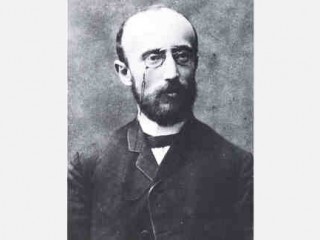
Ahad Ha-Am biography
Date of birth : 1856-08-18
Date of death : 1927-01-02
Birthplace : Skvyra, near Kiev, Ukraine
Nationality : Ukrainian
Category : Famous Figures
Last modified : 2010-12-23
Credited as : Writer, and essayist,
Asher Ginzberg, better known by his pen name Ahad Ha-Am (one of the people), was an intellectual leader whose impression on the writers, politicians, and culture of modern Judaism was profound. His view of cultural Zionism was the inspiration for a rebirth of Hebrew literature and for a renewed interest in the history of Jewish philosophy and ethics.
Ahad Ha-Am was born in a small Ukranian town to a Hasidic family. (Hasidism is a Jewish pietistic sect begun in the 18th century.) He became disillusioned with Hasidism at the age of 13 (the age of Bar Mitzvah, Jewish maturity). For a time he was attracted to the Jewish Enlightenment that advocated integrating Judaism and modern thought. He rejected this thinking because it scorned the traditional forms of Judaism and its cultural tradition, which he considered important. While joining the early Zionists (called "Hovvevi Zion" or "Lovers of Zion"), he looked beyond their political program to its cultural innovations. In Odessa, the center of Jewish life in the Ukraine, he found kindred souls whom he influenced even as they influenced him.
This early experience of moving from one world of thought to another taught him to look skeptically at "causes." He wrote that Jewish intellectuals were advancing and retreating without any sense of order. At one moment they called upon the Jewish people to abandon the tradition; at another they summoned them to reaffirm national culture; at still other times they looked to modern educational systems. He suggested that Jewish intellectuals look to their past, find a continuity with the heart of Judaism, and become not a people "of the book" but a "literary people" whose intellectuals write as a reflection of a vivid cultural life rather than as a substitution for it.
Ahad Ha-Am became a mentor for an entire generation of Jewish intellectuals through his writings, which expressed these ideas. In 1889 he published his first essay, "Lo Zo Ha Derech" (This Is Not the Way). From then until his reflective "Sakh Ha-Kol" (Summing Up) he wrote on topical issues correcting and chastising the Jewish intellectual. His collection of essays At the Crossroads demonstrates his responsive creativity: he investigated the meaning of Jewish ethics as an answer to an English Reform rabbi's essay on Christianity. Essays on Jewish ritual, the Sabbath, and the meaning of tradition came in response to criticisms by Reform and Enlightened Jewish leaders. His view of Zion as a cultural center rather than as merely a political or practical reality was advanced in dialogue with Zionist congresses, speeches, and books.
In 1896 he founded a new type of Hebrew periodical— Hashiloah. The name is that of the river mentioned by Isaiah as one that flows slowly, a symbol of Ahad Ha-Am's Zionism. In that journal the leading Jewish intellectuals— Chaim Nahman Bialik, later Israel's poet laureate; Chaim Weizmann; and others—published their views. In 1899 Ahad Ha-Am founded a secret society, the B'nai Moshe (Sons of Moses). The name reflected his view of the prophetic role. Moses, unlike Aaron the priest, stood as a prophet to chastise and rebuke the people. Priests serve the people and give them what they need. Prophets are a creative opposition party. Although the secret society soon disbanded, Ahad Ha-Am's model of creative opposition was influential among Jewish leaders.
Not only did Ahad Ha-Am act as a spiritual mentor to Jewish thinkers and writers, but he was also an involved activist. He visited the land of Israel (then Palestine) four times—in 1891, 1896, 1899, and 1911—and finally settled there in 1921 until his death on January 2, 1927. Each of these visits occasioned a critical essay. He became more convinced of the possibility of a Jewish cultural revival in the land, but he clearly saw problems others neglected. He recognized the ethical question raised by the Muslim population, but few listened to him. He was also active in the Zionist congresses, although he counted himself as a "mourner at the wedding" at the first congress in 1897. He was an influential force acting against Theodor Herzl's territorialism in the famous Sixth (or Uganda) Congress in 1903, holding out for Israel as the only land in which the Jews could have a homeland. From 1903 to 1921 he lived in London. He was active working against the rabid anti-Zionist faction among assimilated British Jews. He had close ties with Chaim Weizmann and was involved in the negotiations that led to the Balfour Declaration in November 1917, although he was cautious about its real importance.
When Ahad Ha-Am died he was honored by Jews around the world. He was a force that moderated the practical elements of Zionism so that the spiritual and cultural concerns could be given primacy. His revival of Jewish literature and a study of Jewish ethics made him a leader in Jewish thought, and his work for Zionism won him recognition.
There is a fascinating biography of Ahad Ha-Am which reveals the life experience behind his thought: Leon Simon, Ahad Haam: A Biography (1960). A study of his ideas and their importance in Zionism can be found in Norman Bentwich, Ahad Ha-am and His Philosophy (Jerusalem, 1927). A good selection of his essays and a fine analysis of his work is found in Arthur Hertzberg, The Zionist Idea: A Historical Analysis and Reader (1959). The continuing relevance of Ahad Ha-Am is expressed in the critical and insightful collection of essays At the Crossroads: Essays on Ahad Ha-Am, edited by Jacques Kornberg (1983). This volume contains chapters on Ahad Ha-Am as editor of Hashiloah, on the B'nai Moshe, and on his relationship with disciples and colleagues in the Zionist movement.
















